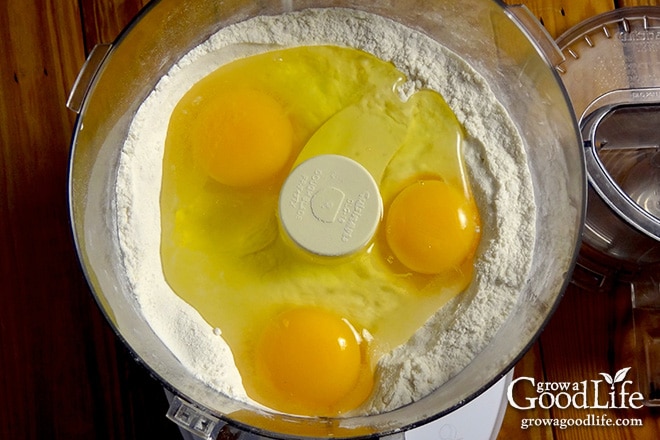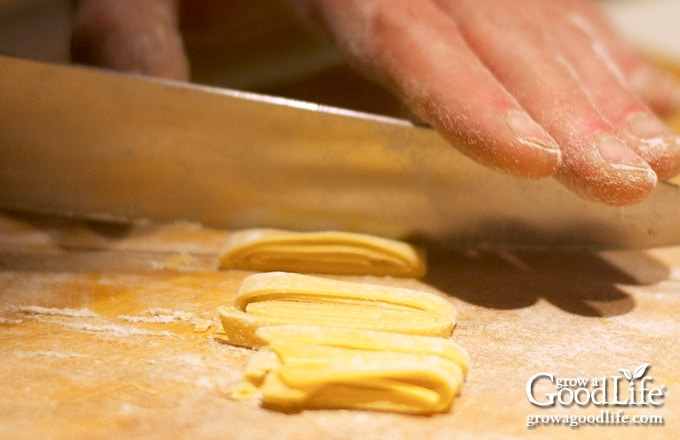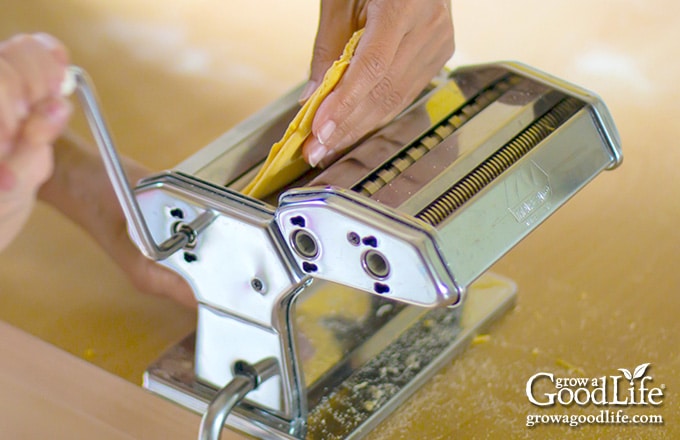Homemade Egg Noodles
This post may contain affiliate links, which means that I may receive a commission if you make a purchase using these links. As an Amazon Associate I earn from qualifying purchases.
Three simple ingredients are all you need to make your own fresh, homemade egg noodles. Learn how to make noodles from scratch with this easy recipe.

Recently, Kevin came down with a cold. When you are sick with a cold, there is nothing more comforting than homemade chicken noodle soup. I had some chicken soup in the freezer, but I didn’t have any boxed pasta in the pantry. It was then that I remembered how easy it is to make your own egg noodles from scratch.
I used to make pasta from scratch all the time, but stopped after a period of pain associated with tendonitis and carpel tunnel syndrome in my wrists. Now that I am armed with additional kitchen appliances to help with kneading the dough, I couldn’t wait to make my own egg noodles again. Using fresh eggs from our chickens makes homemade egg noodles extra special.
Tips for Making Egg Noodles from Scratch
Egg noodles are a type of pasta shaped in flat, short ribbons in fine, broad, wide, or extra wide widths. They are most often used in soups and casseroles.
The ingredients for noodles are simple, just wheat flour, salt, and eggs. These are combined into a dough that is rolled thin and cut into noodle shapes.
You can, of course make and knead the dough by hand. However, if you lack the manual strength for kneading, consider using a food processor or stand mixer with dough hook to take on some of the labor to bring the dough together.

My Italian Auntie didn’t have any fancy equipment. Heck, she didn’t even use a recipe to make her pasta. She began with a few scoopfuls of flour on a large cutting board, made a well in the center, and added her eggs and a pinch of salt. She used her fingers to scramble the eggs and gently pull in the flour from the sides. She mixed the dough together until combined, adding flour as needed until the dough felt right. Then she continued kneading the dough until it formed a smooth ball.
Cutting the Egg Noodles by Hand
To roll your dough by hand, divide the dough into sections and roll them out one at a time.
Dust the dough, work area, and rolling pin with flour as need to prevent sticking as you roll. Lift the dough and turn frequently to help prevent sticking. Keep rolling until the dough is 1/16-inches (4 mm) thick for egg noodles.
Use a knife or pizza cutter to slice the pasta sheets into egg noodle shapes about 2 x 1/2 inch (5 cm x 1 cm). Sprinkle flour on the noodles, spread them out in a single layer, and set aside while you work with the rest of the dough.
Auntie used a rolling pin to roll out the pasta dough and cut the pasta shapes by hand with her pastry cutter or sharp knife. Hand cutting creates a charming, rustic looking egg pasta noodle that brings back warm childhood memories of large family dinners on Sunday.

Use a Pasta Machine to Make the Noodles
After mixing, running the dough through a pasta machine makes it really easy to form the noodles.
Start out at the thickest setting on your pasta machine. Working in batches, slice off a section of dough, flatten it with your hands, and run it through the machine.
Fold the sheet into thirds and then run it through the machine two more times.
Reduce the setting to the next lower level and run the dough through the machine again. Do not fold. Run through the machine again.
Dust the dough with flour as needed to prevent sticking and keep going until the dough is 1/16-inch (4 mm) thick for egg noodles.
Feel free to cut the sheets of pasta to more manageable lengths at any point in the process. Don’t fret if your pasta sheets get messed up. Just fold it up, flatten it out, and begin again at the thickest setting.
Once the pasta dough is 1/16-inch (4 mm) thick, cut the sheet to egg noodle size of about 2-inches, then run through the pasta machine’s wide noodle cutter.
Dust the noodles with four, spread out into a single layer, and set aside while you work with the rest of the dough.

Preserving Egg Noodles for Later
Homemade noodles should be used right away, refrigerated, or frozen for longer storage. There are two ways you can store homemade egg noodles, refrigerating or freezing. Storing at room temperature is no longer recommended. Dough that contains raw eggs and flour should be refrigerated or frozen for safety.
Drying Egg Noodles
There are two methods for drying homemade egg noodles, air-drying and using a food dehydrator. With either method, the egg noodles must be completely dry before you store them. You can tell when the noodles are dry, by bending them in half. They should snap easily.
- Air Drying: Dry the noodles by hanging on a pasta drying rack, or spread them out in a single layer onto well-floured baking sheets and allow the noodles to dry for 1-2 hours. Store the dried noodles in an airtight container for up to two days in the refrigerator, or freeze for up to 6 months. To prevent salmonella, the egg noodles should not be left out at room temperature for more than 2 hours.
- Drying with a Food Dehydrator: Place the noodles in a single layer on the drying screens of the food dehydrator and dry at about 135˚F for 2 to 4 hours (follow the manufacturer’s directions). Store the dried egg noodles in an airtight container for up to two days in the refrigerator, or freeze for up to 6 months.
Freezing Egg Noodles
To freeze your egg noodles, spread them out in a single layer on parchment lined baking sheets. Place the sheets into the freezer and freeze the noodles for about 15 minutes, or until the individual pieces aren’t sticking to each other or the pan. Once they are frozen, package them up into freezer bags, seal, date, and store for up to 6 months.
Cooking Dried or Frozen Noodles
Bring a pot of water to a boil over high heat, add the frozen or dried noodles to the pot. Stir gently to prevent the noodles from sticking together. Cook until the noodles are tender and cooked through, about 10 to 12 minutes.

Homemade Egg Noodles Recipe
Ingredients
- 2 cups unbleached all-purpose flour plus extra for kneading and dusting
- 1/2 teaspoon kosher salt
- 3 large eggs
Instructions
- Place the flour and salt in the bowl of a food processor and pulse once or twice to combine.
- Add the eggs and process until the dough comes together in a loose ball. If the dough remains dry and crumbly, add about a teaspoon of water and process again. If the dough is sticky, add some flour and process again. Repeat if necessary until the dough comes together.
- Remove the dough from the processor and knead it by hand briefly on a floured surface until it forms a smooth ball.
- Sprinkle the dough with flour, cover with a kitchen towel, and let rest for 30 minutes at room temperature.
- Slice off sections of the dough and roll out to about 1/16-inch (4 mm) thick using a pasta machine or rolling pin. Cut into egg noodle shapes of about 2 x 1/2 inch (5 cm x 1 cm) strips. Dust with flour and set aside.
- Bring a large pot of salted water to a boil. Drop the fresh noodles into the boiling water a few at a time and stir to keep them from clumping. Cook for 2 to 4 minutes, or until done. Drain and serve. Makes 4 to 6 generous servings.
Nutrition
These homemade egg noodles are perfect for turkey noodle soup but can also be enjoyed tossed with some butter, Parmesan cheese, and a sprinkle of fresh herbs, or topped with homemade tomato sauce.
This article was originally published on April 7, 2016. It has been updated with additional information.
You May Also Like:
- Quick Tomato Sauce with Fresh Tomatoes
- Home-style Turkey Soup Recipe
- How to Home Can Chicken Soup
- No Knead Dutch Oven Bread
10 Cookie Mix in a Jar Recipes eBook
Homemade gifts are always appreciated because they come from the heart. Even if you are not crafty, you can give DIY gifts to your family and friends with these easy recipes for making cookie mix in a reusable jar.


If I want to use the noodles for another recipe, like a soup, do I follow the recipe and then use the cooked noodles or do I cook the noodles directly into the hot soup? Is there a way to make ahead of time or store, could you freeze them?
Mary, You can cook the noodles or separately. Just keep in mind that the noodles absorb liquid, so you may need to use more stock or broth in your soup. You can keep cooked noodles in the refrigerator for 3 to 4 days. Then, reheat leftovers to at least 165°F before serving. Please see the section titled “Preserving Egg Noodles for Later” for ways to make and store the noodles.
I am about to teach a friend to make egg noodles at home, and since I love looking at recipes I have been online looking at them. Your recipe is the one I will give her as a reference, is how I have made them since a kid though I am still doing it by hand. Different flours change the gluten and thus the hard work – I use spelt or einkorn for most baking but prefer a bit more gluten for my noodles.
Thank you for “the recipe”.
Jan, Thank you for your comment. I hope your friend finds the recipe helpful. It does take some practice to learn how the dough should feel when kneading, but even when it isn’t perfect, it still tastes good.
Loved making them and enjoyed using up some extra eggs. One comment on the thickness, 1/16 = .0625″, 4mm=.157″, closer would be 1.5mm at .059″. I made a batch at the 4mm out of curiosity and found them extremely tasty and similar to dumplings from Cracker Barrel.
Desmond, Ooh, I really did get the conversion from inches to mm wrong, didn’t I? I am so sorry about that. I am glad you enjoyed the egg noodles anyway.
Thank you so much for posting this article. Today I tried making these noodles and could make them very easily all because of your efforts and guidance. Keep posting such articles they are very helpful.
When I dry the noodles for longer than 10 hours they darken in color What am I doing wrong? I roll out on the counter and cover with a dish towel the roll and cut. Thoughts?
Pam, I am so sorry that your egg noodles turned brown. There are several reasons why that would happen. There could be minerals in the water, or the sulfur in the eggs can cause a chemical reaction and turn brown or grey. More importantly, after this recipe was published, the USDA has recommended that homemade egg noodles that contain raw eggs and flour should no longer be left at room temperature to dry for more than 2 hours. I have updated the article to reflect these changes.
I just found you! I’m excited to find someone egg noodle crazy like I am. I make homemade also. Not quite your recipe, but I’m trying yours tomorrow. Have you ever made your noodles into a sweet dumpling dish? I cook the sweet fruit syrup and noodles separate, then combine them. The fruit combinations are endless. My family loves this in the cold months.
Maggie, That sounds delicious!
How many noodles (in pounds or ounces) are made using the recipe provided?
Chris, This recipe makes about a pound of egg noodles.
Tomorrow is Thanksgiving, and I’m just getting ready to begin my noodles. My parents are both of German ancestry, and homemade noodles were a staple, especially for Thanksgiving and Christmas. I don’t have a food processor, and I’ve only done them on a counter with a flour “well.” I wanted to check out other recipes, but tradition rules! Mom always used one extra egg yolk for added richness. What little flour remained on the noodles after giving a good shaking, made the broth thicken. Best thing instead of gravy on mashed potatoes! And on the dressing. And a little on the turkey. And in a dish of noodles for later on. Always make lots for later. It’s wonderful to hear from all those who still love to make their food from scratch, and enjoy the goodness that comes from making it yourself. HAPPY THANKSGIVING and MERRY CHRISTMAS!